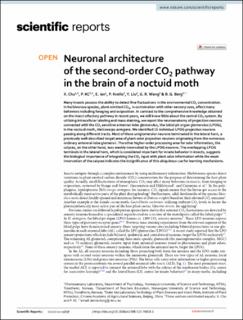Neuronal architecture of the second-order CO2 pathway in the brain of a noctuid moth
| dc.contributor.author | Chu, Xi | |
| dc.contributor.author | KC, Pramod | |
| dc.contributor.author | Ian, Elena | |
| dc.contributor.author | Kvello, Pål | |
| dc.contributor.author | Liu, Yand | |
| dc.contributor.author | Wang, Guirong | |
| dc.contributor.author | Berg, Bente Gunnveig | |
| dc.date.accessioned | 2022-05-03T12:30:23Z | |
| dc.date.available | 2022-05-03T12:30:23Z | |
| dc.date.created | 2020-11-24T16:51:51Z | |
| dc.date.issued | 2020 | |
| dc.identifier.issn | 2045-2322 | |
| dc.identifier.uri | https://hdl.handle.net/11250/2993943 | |
| dc.description.abstract | Many insects possess the ability to detect fine fluctuations in the environmental CO2 concentration. In herbivorous species, plant-emitted CO2, in combination with other sensory cues, affect many behaviors including foraging and oviposition. In contrast to the comprehensive knowledge obtained on the insect olfactory pathway in recent years, we still know little about the central CO2 system. By utilizing intracellular labeling and mass staining, we report the neuroanatomy of projection neurons connected with the CO2 sensitive antennal-lobe glomerulus, the labial pit organ glomerulus (LPOG), in the noctuid moth, Helicoverpa armigera. We identified 15 individual LPOG projection neurons passing along different tracts. Most of these uniglomerular neurons terminated in the lateral horn, a previously well-described target area of plant-odor projection neurons originating from the numerous ordinary antennal-lobe glomeruli. The other higher-order processing area for odor information, the calyces, on the other hand, was weakly innervated by the LPOG neurons. The overlapping LPOG terminals in the lateral horn, which is considered important for innate behavior in insects, suggests the biological importance of integrating the CO2 input with plant odor information while the weak innervation of the calyces indicates the insignificance of this ubiquitous cue for learning mechanisms. | en_US |
| dc.language.iso | eng | en_US |
| dc.publisher | Nature Research | en_US |
| dc.rights | Navngivelse 4.0 Internasjonal | * |
| dc.rights.uri | http://creativecommons.org/licenses/by/4.0/deed.no | * |
| dc.title | Neuronal architecture of the second-order CO2 pathway in the brain of a noctuid moth | en_US |
| dc.title.alternative | Neuronal architecture of the second-order CO2 pathway in the brain of a noctuid moth | en_US |
| dc.type | Peer reviewed | en_US |
| dc.type | Journal article | en_US |
| dc.description.version | publishedVersion | en_US |
| dc.source.volume | 10 | en_US |
| dc.source.journal | Scientific Reports | en_US |
| dc.identifier.doi | 10.1038/s41598-020-76918-1 | |
| dc.identifier.cristin | 1851847 | |
| dc.relation.project | Norges forskningsråd: 287052 | en_US |
| cristin.ispublished | true | |
| cristin.fulltext | original | |
| cristin.qualitycode | 1 |
Tilhørende fil(er)
Denne innførselen finnes i følgende samling(er)
-
Institutt for lærerutdanning [3564]
-
Institutt for psykologi [3079]
-
Publikasjoner fra CRIStin - NTNU [38015]

